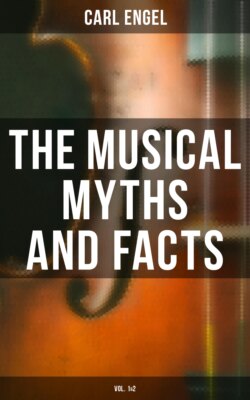Читать книгу The Musical Myths and Facts (Vol. 1&2) - Engel Carl - Страница 12
На сайте Литреса книга снята с продажи.
HINDU TRADITIONS.
ОглавлениеTable of Contents
Mia Tonsine, a wonderful musician in the time of the Emperor Akber, sang one of the night-rags at mid-day. The power of the music was such that it instantly became night, and the darkness extended in a circle round the palace as far as the sound of the voice could be heard. Rags are characteristic songs composed in certain modes or scales; and each Rag is appropriated to a distinct season, in which alone it must be sung or played at prescribed hours of the day or night; for, over each of the six Rags, or kinds of compositions, presides a certain god, who presides likewise over the six seasons. The six seasons are: Seesar, the dewy season; Heemat, the cold season; Vasant, the mild season, or spring; Greesshma, the hot season; Varsa, the rainy season; and Sarat, the breaking-up, or end of the rains.[10]
Whoever shall attempt to sing the Rag Dheepuck (or "Cupid the Inflamer") is to be destroyed by fire. The Emperor Akber ordered Naik Gopaul, a celebrated musician, to sing that Rag. Naik Gopaul endeavoured to excuse himself, but in vain; the Emperor insisted on obedience. The unhappy musician therefore requested permission to go home, and to bid farewell to his family and friends. It was winter when he returned, after an absence of six months. Before he began to sing he placed himself in the waters of the Jumna till they reached his neck. As soon as he had performed a strain or two the river gradually became hot; at length it began to boil, and the agonies of the unhappy musician were nearly insupportable. Suspending for a moment the melody thus cruelly extorted, he sued for mercy from the monarch, but sued in vain. Akber wished to prove more strongly the powers of the Rag Dheepuck. Naik Gopaul renewed the fatal song: flames burst with violence from his body, which, though immersed in the waters of the Jumna, was consumed to ashes.
The effect produced by the Rag called Maig Mullaar is immediate rain. It is told that a singing girl once, by exerting the powers of her voice in this Rag, drew from the clouds timely and refreshing showers on the parched rice-crops of Bengal, and thereby averted the horrors of famine from the "Paradise of Regions," as the province of Bengal is sometimes called.
Sir William Ouseley, who obtained these traditions, it would appear, from oral communication, states that they are related by many of the Hindus, and implicitly believed by some. However, on inquiring of the people whether there are still musical performers among them who can produce effects similar to those recorded, one is gravely told that the art is now almost lost, but that there are still musicians possessed of miraculous powers in the west of Hindustan; and if one inquires in the west, they say that should any such musicians remain, they must be found in Bengal.[11]
A reliable collection of Hindu traditions relating to music might, probably, be suggestive and valuable to the musical historian, especially if he examined them with reference to the myths of the ancient Egyptians and Greeks.
